C++标准输入流、输出流以及文件流
1、流的控制
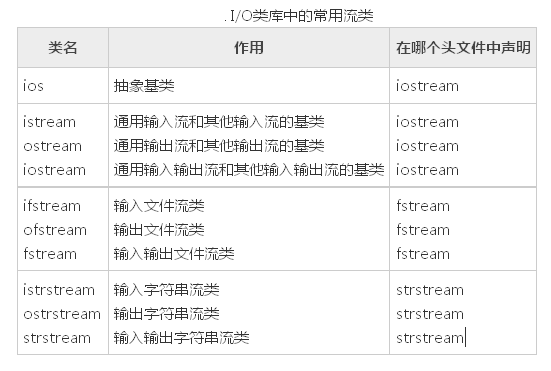
iomanip 在使用格式化I/O时应包含此头文件。
stdiostream 用于混合使用C和C + +的I/O机制时,例如想将C程序转变为C++程序
2、类继承关系
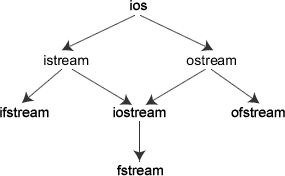
ios是抽象基类,由它派生出istream类和ostream类, iostream类支持输入输出操作,iostream类是从istream类和ostream类通过多重继承而派生的类
类ifstream继承了类istream,类ofstream继承了类ostream,类fstream继承了 类iostream
iostream头文件中4种流对象
| 对象 |
含义 |
对应设备 |
对应的类 |
c语言中相应的标准文件 |
| cin |
标准输入流 |
键盘 |
istream_withassign |
stdin |
| cout |
标准输出流 |
屏幕 |
ostream_withassign |
stdout |
| cerr |
标准错误流 |
屏幕 |
ostream_withassign |
stderr |
| clog |
标准错误流 |
屏幕 |
ostream_withassign |
stderr |
cout补充
1、用“cout<<”输出基本类型的数据时,可以不必考虑数据是什么类型,系统会判断数据的类型
并根据其类型选择调用与之匹配的运算符重载函数。这个过程都是自动的,用户不必干预。
如果在C语言中用prinf函数输出不同类型的数据,必须分别指定相应的输出格式符,十分麻烦,而且容易出错
2、cout流在内存中对应开辟了一个缓冲区,用来存放流中的数据,当向cout流插 人一个endl时,
不论缓冲区是否已满,都立即输出流中所有数据,然后插入一个换行符, 并刷新流(清空缓冲区)。
注意如果插人一个换行符”\n“(如cout<<a<<"\n"),则只输出和换行,而不刷新cout 流(但并不是所有编译系统都体现出这一区别)。
3、在iostream中只对"<<"和">>"运算符用于标准类型数据的输入输出进行了重载,但未对用户声明的类型数据的输入输出 进行重载。
如果用户声明了新的类型,并希望用"<<"和">>"运算符对其进行输入输出,按照重运算符重载来做。
cout 流通常是传送到显示器输出,但也可以被重定向 输出到磁盘文件,而cerr流中的信息只能在显示器输出
cerr是不经过缓冲区,直接向显示器上输出有关信息,而clog中的信息存放在缓冲区中,缓冲区满后或遇endl时向显示器输出
3、标准输入流 cin
重点掌握的函数
cin.get() //读入一个字符并返回它的值
cin.get(一个参数) //读入一个字符并把它存储在ch
cin.get(两个参数) //可以读取字符串
cin.get(三个参数) //可以读字符串
cin.getline()
cin.ignore() //读取字符并忽略指定字符
cin.peek() //检查下一个输入的字符,不会把字符从流中移除
cin.putback() //返回一个字符给一个流
重要
1、使用cin,从流中读出的字符,流中就没有这字符了,再次读取时只能读取剩下的
2、缓冲去只有在遇到EOF、手动敲回车、流(缓存区)满时,才将流中的字符全部读出(即清空缓存区)
练习
1、从流中取一个字符,然后在放进去;
2、判断流中的第一个字符是不是放进去的那个字符;
3、从流中读取10个字符;
4、从流中忽略5个字符,再读取10个字符;
5、最后读取剩下的字符,最后输出读到的所有字符
#include <iostream>
using namespace std;
int main()
{
char ch1;
int look;
char str1[11] = {0};
char str2[11] = {0};
char str3[100] = {0};
<span class="hljs-comment">//从流中取一个字符,然后在放进去</span>
ch1 = <span class="hljs-built_in">cin</span>.get();
<span class="hljs-built_in">cin</span>.putback(ch1);
<span class="hljs-comment">//判断流中的第一个字符是不是放进去的那个字符</span>
look = <span class="hljs-built_in">cin</span>.peek();
<span class="hljs-keyword">if</span>(look == (<span class="hljs-keyword">int</span>)ch1)
{
<span class="hljs-built_in">cout</span><<<span class="hljs-string">"cin.peek()放进去的字符在第一个位置"</span><<<span class="hljs-built_in">endl</span>;
}
<span class="hljs-keyword">else</span>
{
<span class="hljs-built_in">cout</span><<<span class="hljs-string">"cin.peek()放进去的字符不是在第一个位置"</span><<<span class="hljs-built_in">endl</span>;
}
<span class="hljs-comment">//从流中读取10个字符</span>
<span class="hljs-built_in">cin</span>.get(str1,<span class="hljs-number">11</span>);
<span class="hljs-comment">//从流中忽略5个字符,再读取10个字符</span>
<span class="hljs-built_in">cin</span>.ignore(<span class="hljs-number">5</span>);
<span class="hljs-built_in">cin</span>.get(str2,<span class="hljs-number">11</span>,EOF);
<span class="hljs-comment">//最后读取剩下的字符,最后输出读到的所有字符</span>
<span class="hljs-built_in">cin</span>.getline(str3,<span class="hljs-number">100</span>);
<span class="hljs-comment">//输出读到的数据</span>
<span class="hljs-built_in">cout</span><<<span class="hljs-string">"第一个字符"</span><<ch1<<<span class="hljs-built_in">endl</span>;
<span class="hljs-built_in">cout</span><<<span class="hljs-string">"第一组 字符串:"</span><<str1<<<span class="hljs-built_in">endl</span>;
<span class="hljs-built_in">cout</span><<<span class="hljs-string">"第二组 字符串:"</span><<str2<<<span class="hljs-built_in">endl</span>;
<span class="hljs-built_in">cout</span><<<span class="hljs-string">"剩下的字符串:"</span><<str3<<<span class="hljs-built_in">endl</span>;
system(<span class="hljs-string">"pause"</span>);
<span class="hljs-keyword">return</span> <span class="hljs-number">0</span>;
}
输出:
0123456789abcde9876543210zzzzzzzzzzxxxxxxxxxxxxxyyyyyyyyyyyy
cin.peek()放进去的字符在第一个位置
第一个字符0
第一组 字符串:0123456789
第二组 字符串:9876543210
剩下的字符串:zzzzzzzzzzxxxxxxxxxxxxxyyyyyyyyyyyy4、标准输出流 cout
流成员函数
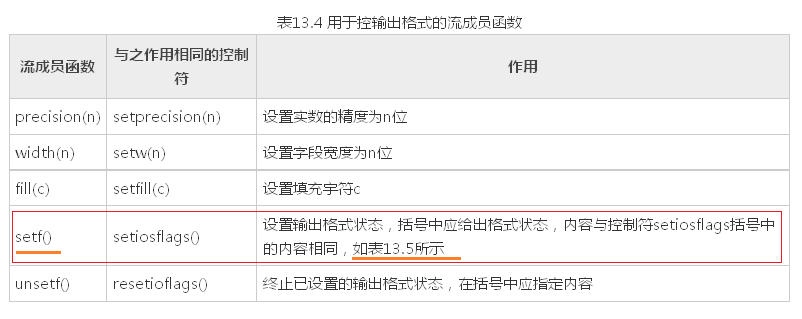
cout.flush() //清空缓冲区
cout.put() //把字符写入流中
cout.write() //将字符串写入当前输出流中
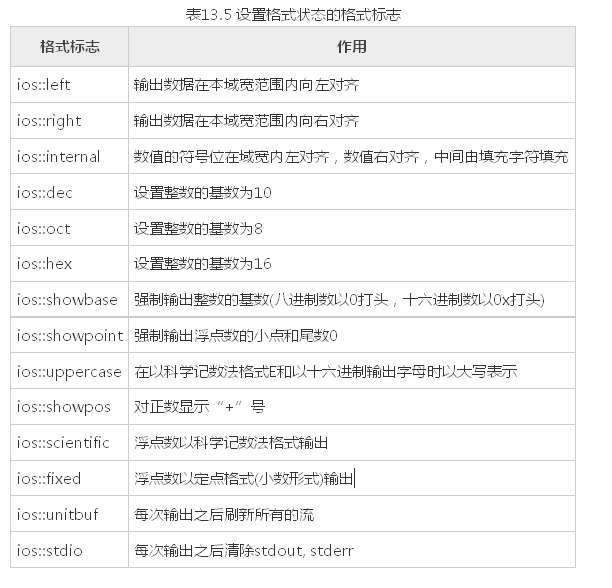
eg : cout.setf( ios::dec );
cout.setf(ios::hex,ios::basefield);【建议使用这种】
需注意:1、fmtflags setf( fmtflags flags ); 使用这种,一定要先取消当前基【cout.unself()】,之后才可以设置新的基
2、fmtflags setf( fmtflags flags, fmtflags needed ); 使用这种,第二个参数设为当前的基,或者当不知道当前基时,设为ios_base::basefield清除当前的所有可能的基
控制符,头文件<iomanip>

eg: cout<<setw(5);
5、文件I/O
由于文件设备并不像显示器屏幕与键盘那样是标准默认设备,不能像cout那样预先定义的全局对象,所以我们必须自己定义一个该类的对象。
ifstream类,它是从istream类派生的,用来支持从磁盘文件的输入。
ofstream类,它是从ostream类派生的,用来支持向磁盘文件的输出。
fstream类,它是从iostream类派生的,用来支持对磁盘文件的输入输出。
文件原理
文件打开都有一个文件指针,该指针的初始位置由I/O方式指定,每次读写都从文件指针的当前位置开始。每读入一个字节,指针就后移一个字节。当文件指针移到最后,就会遇到文件结束EOF(文件结束符也占一个字节,其值为-1),此时流对象的成员函数eof的值为非0值(一般设为1),表示文件结束 了。
文件关闭,实际上是解除该磁盘文件与文件流的关联,原来设置的工作方式也失效,这样,就不能再通过文件流对该文件进行输入或输出
文件类型:1、ASCII文件:文件的每一个字节中均以ASCII代码形式存放数据,即一个字节存放一个字符,这个文件就是ASCII文件(或称字符文件)。
2、二进制文件:文件中的信息不是字符数据,而是字节中的二进制形式的信息,因此它又称为字节文件
常用函数
打开文件:
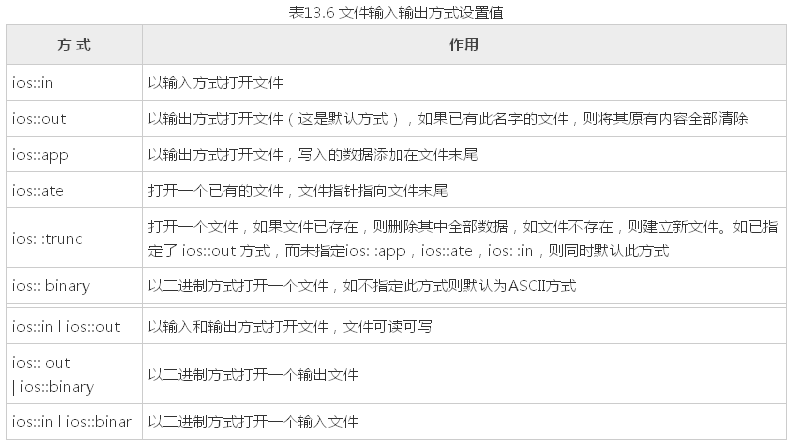
方式1:对文件输出流、文件流对象,通过ofstream类的构造函数打开文件
格式: ofstream (磁盘文件名, 输入输出方式);
如果ofstream 为0(假),表示打开操作失败
如: ofstream fout1(fname,ios::out);
输入输出方式可以使用能够进行组合使用的,以“或”运算(“|”)的方式,如:fstream fout(fname,ios::out|ios::in)
方式2:对文件的输出和输入流对象、文件流对象,都可通过open函数打开文件
格式: 文件流对象.open(磁盘文件名, 输入输出方式);
返回值:为0(假),打开操作失败
如: fout.open(fname,ios::out)
关闭文件:
在对已打开的磁盘文件的读写操作完成后,必须要关闭该文件 如: outfile.close( );
文件操作
1、可以用流插入运算符“<<”和流提取运算符“>>”输入输出标准类型的数据(>> 读出时在遇空格、换行都结束)。
2、也可以用文件流的put、get、geiline等成员函数进行字符的输入输出。
#include <iostream>
using namespace std;
#include "fstream"
int main()
{
char fname[] = "d:/file1.txt";
char buff[1024]= {0};
/*********** 写文件 *************/
//方式1 输出流ofstream对象调用fopen函数
ofstream fout;
fout.open(fname,ios::out);
if(!fout)
{
cout<<"打开文件失败"<<fname<<endl;
}
fout<< "hello world !"; //通过左移运算符写入字符串
fout.flush();
fout.close();
<span class="hljs-comment">//方式2 调用输出流ofstream对象的构造函数</span>
<span class="hljs-function">ofstream <span class="hljs-title">fout1</span><span class="hljs-params">(fname,ios::out)</span></span>;
<span class="hljs-keyword">if</span>(!fout1)
{
<span class="hljs-built_in">cout</span><<<span class="hljs-string">"打开文件失败"</span><<fname<<<span class="hljs-built_in">endl</span>;
}
fout1.put(<span class="hljs-string">'h'</span>); <span class="hljs-comment">//通过put函数写入字符</span>
fout1.put(<span class="hljs-string">'e'</span>);
fout1.put(<span class="hljs-string">'l'</span>);
fout1.put(<span class="hljs-string">'l'</span>);
fout1.put(<span class="hljs-string">'o'</span>);
fout1.put(<span class="hljs-string">'\n'</span>);
fout1.flush();
fout1.close();
<span class="hljs-comment">//文件流对象写文件</span>
<span class="hljs-function">fstream <span class="hljs-title">file2</span><span class="hljs-params">(fname,ios::in|ios::out)</span></span>;
file2<<<span class="hljs-string">"abdfd\n"</span>;
file2<<<span class="hljs-string">"11111\n"</span>;
file2.flush();
file2.close();
<span class="hljs-comment">/*********** 读文件 *************/</span>
<span class="hljs-comment">//输入流ifstream对象读取文件内容</span>
ifstream fin;
fin.open(fname,ios::in);
fin.getline(buff,<span class="hljs-number">1024</span>); <span class="hljs-comment">//通过getline函数读取字符串</span>
<span class="hljs-built_in">cout</span><<buff<<<span class="hljs-built_in">endl</span>;
fin.close();
<span class="hljs-comment">//文件流对象读文件内容</span>
<span class="hljs-function">fstream <span class="hljs-title">file1</span><span class="hljs-params">(fname,ios::in|ios::out)</span></span>;
file1>>buff; <span class="hljs-comment">//通过右移运算符读出字符串</span>
file1.close();
<span class="hljs-built_in">cout</span><<buff<<<span class="hljs-built_in">endl</span>;
system(<span class="hljs-string">"pause"</span>);
<span class="hljs-keyword">return</span> <span class="hljs-number">0</span>;
}
二进制文件操作
对二进制文件的读写主要用istream类的成员函数read和write来实现。这两个成员函数的原型为
istream& read(char *buffer,int len);
ostream& write(const char * buffer,int len);
#include <iostream>
using namespace std;
#include <fstream>
class Teacher
{
public:
Teacher()
{
}
Teacher(<span class="hljs-keyword">int</span> age,<span class="hljs-keyword">char</span> name[<span class="hljs-number">20</span>])
{
<span class="hljs-keyword">this</span>->age = age;
<span class="hljs-built_in">strcpy</span>(<span class="hljs-keyword">this</span>->name,name);
}
<span class="hljs-function"><span class="hljs-keyword">void</span> <span class="hljs-title">prinfInfo</span><span class="hljs-params">()</span>
</span>{
<span class="hljs-built_in">cout</span><<<span class="hljs-string">"Teacher name:"</span><<<span class="hljs-keyword">this</span>->name<<<span class="hljs-string">" age:"</span><<<span class="hljs-keyword">this</span>->age<<<span class="hljs-built_in">endl</span>;
}
private:
int age;
char name[20];
};
int main()
{
Teacher t1(31,"xiaoming");
Teacher t2(32,"xiaohong");
Teacher t3(33,"xiaohua");
Teacher t4(34,"xiaoxin");
char fname[] = "d:/file2";
fstream fs(fname,ios::binary|ios::out);
if(!fs)
{
cout<<"文件打开失败"<<endl;
}
fs.write((char *)&t1,sizeof(Teacher));
fs.write((char *)&t2,sizeof(Teacher));
fs.write((char *)&t3,sizeof(Teacher));
fs.write((char *)&t4,sizeof(Teacher));
fs.flush();
fs.close();
<span class="hljs-function">fstream <span class="hljs-title">fs2</span><span class="hljs-params">(fname,ios::binary|ios::in)</span></span>;
<span class="hljs-keyword">if</span>(!fs)
{
<span class="hljs-built_in">cout</span><<<span class="hljs-string">"文件打开失败"</span><<<span class="hljs-built_in">endl</span>;
}
Teacher tt;
fs2.read((<span class="hljs-keyword">char</span> *)&tt,<span class="hljs-keyword">sizeof</span>(Teacher));
tt.prinfInfo();
fs2.read((<span class="hljs-keyword">char</span> *)&tt,<span class="hljs-keyword">sizeof</span>(Teacher));
tt.prinfInfo();
fs2.read((<span class="hljs-keyword">char</span> *)&tt,<span class="hljs-keyword">sizeof</span>(Teacher));
tt.prinfInfo();
fs2.read((<span class="hljs-keyword">char</span> *)&tt,<span class="hljs-keyword">sizeof</span>(Teacher));
tt.prinfInfo();
fs2.close();
system(<span class="hljs-string">"pause"</span>);
<span class="hljs-keyword">return</span> <span class="hljs-number">0</span>;
}
输出:
Teacher name:xiaoming age:31
Teacher name:xiaohong age:32
Teacher name:xiaohua age:33
Teacher name:xiaoxin age:34





